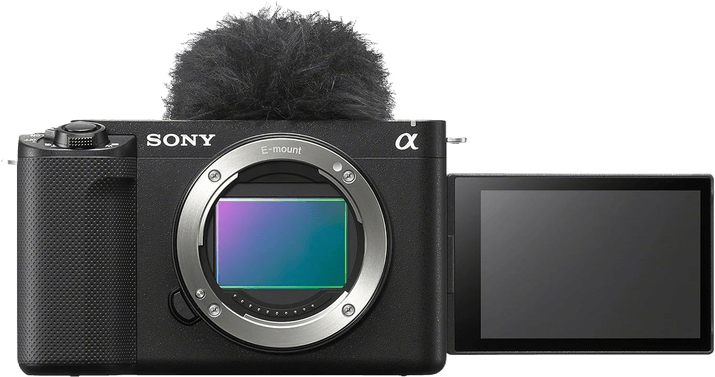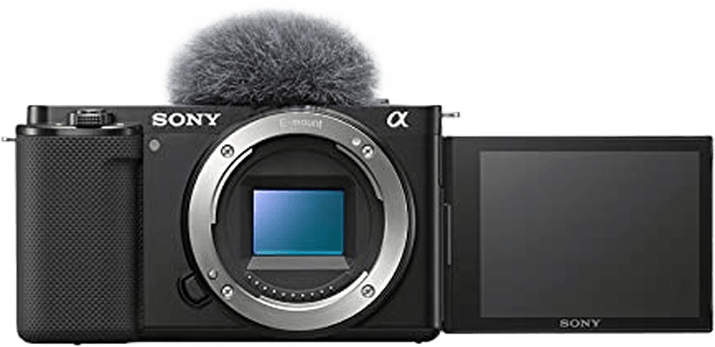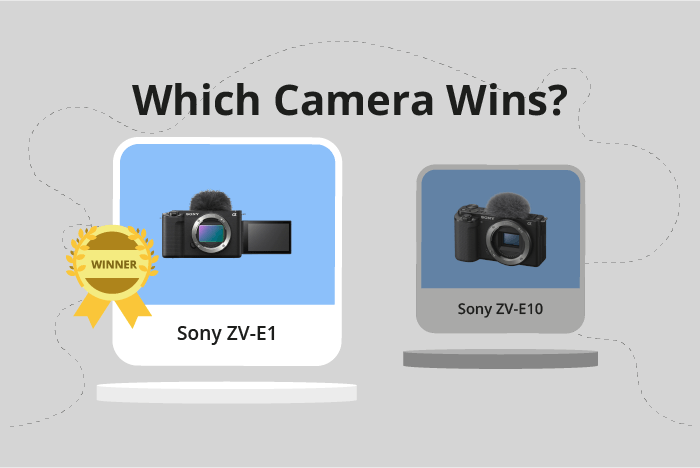Sony ZV-E1 vs ZV-E10 Comparison
Sony ZV-E1

Sony ZV-E10

The Sony ZV-E1 outperforms the Sony ZV-E10 with a score of 72/100 compared to 65/100. Both cameras are mirrorless and share similar specifications, such as dimensions and weight. The ZV-E1 measures 121 x 72 x 54mm and weighs 483g, while the ZV-E10 is slightly smaller and lighter at 115 x 64 x 45mm and 343g.
The ZV-E1 has the advantage of being a newer model, released in 2023, which could contribute to its higher score. However, the ZV-E10 holds its own with a significantly lower launch price of $700 compared to the ZV-E1’s $2200.
Taking these factors into account, the Sony ZV-E1 offers better performance and more up-to-date features, while the Sony ZV-E10 provides a more budget-friendly option without compromising too much on quality.
Sony ZV-E1 vs ZV-E10 Overview and Optics
The Sony ZV-E1 wins in the optics comparison with a score of 71/100, while the Sony ZV-E10 follows closely with a score of 69/100. Both cameras share common specifications such as a CMOS sensor, Sony E lens mount, and the ability to shoot at high speeds (10 fps for the ZV-E1 and 11 fps for the ZV-E10).
The ZV-E1 outperforms the ZV-E10 in several aspects. It has a higher DXOMARK score for its sensor (93 vs. 86), indicating better overall image quality. Furthermore, the ZV-E1 features a full-frame sensor, which allows for better low-light performance and increased dynamic range compared to the APS-C sensor found in the ZV-E10. The ZV-E1 also has image stabilization, providing steadier shots and reducing the chance of blurry images.
On the other hand, the ZV-E10 boasts a higher megapixel count (24 vs. 12), resulting in more detailed images and better cropping flexibility. Additionally, the ZV-E10 has a faster shooting speed (11 fps vs. 10 fps), which can be beneficial for capturing fast-moving subjects. However, it lacks image stabilization, which may result in less stable images.
In terms of optics, the Sony ZV-E1 is the better choice due to its superior sensor performance and the presence of image stabilization. The full-frame sensor provides better image quality, especially in low-light situations. However, the Sony ZV-E10 offers advantages in terms of higher resolution and faster shooting speed. Ultimately, the decision between these two cameras will depend on the user’s priorities and specific needs.
Sony ZV-E1 vs ZV-E10 Video Performance
The Sony ZV-E10 outperforms the Sony ZV-E1 in video capabilities with a score of 91/100 compared to the ZV-E1’s 77/100. Both cameras share common specifications, such as 4K max video resolution, 120fps max video frame rate, and similar max video dimensions (3840 x 2160 for the ZV-E1 and 3840 x 1920 for the ZV-E10). However, the ZV-E10 has several advantages that contribute to its higher score.
The ZV-E10’s superiority lies in its built-in time-lapse functionality, which the ZV-E1 lacks. This feature allows users to create stunning time-lapse videos without the need for additional equipment or software. The slight difference in max video dimensions, with the ZV-E10 having a slightly wider aspect ratio, also contributes to its higher video score.
On the other hand, the ZV-E1 does not offer any specific advantages in video capabilities over the ZV-E10. Both cameras have the same max video resolution and frame rate, making them equally suitable for high-quality video recording. The only minor difference is in the max video dimensions, but this does not give the ZV-E1 any significant edge over the ZV-E10.
Considering the video capabilities of both cameras, the Sony ZV-E10 is the clear winner due to its built-in time-lapse functionality and slightly wider max video dimensions. The Sony ZV-E1, while still a capable camera, falls short in these aspects. For users who prioritize video features, the ZV-E10 is the better choice.
Sony ZV-E1 vs ZV-E10 Features and Benefits
The Sony ZV-E1 outperforms the Sony ZV-E10 in terms of features, scoring 83/100 compared to the ZV-E10’s 68/100. Both cameras share several specifications, such as a 3-inch screen size, touchscreen capabilities, a flip screen, GPS absence, WIFI, and Bluetooth connectivity.
The ZV-E1 surpasses the ZV-E10 in screen resolution, boasting 1,036,800 dots compared to the ZV-E10’s 920,000 dots. This higher resolution provides the ZV-E1 with a sharper and clearer display, allowing for more precise image review and better user experience.
However, the ZV-E10 does not possess any notable advantages over the ZV-E1. Both cameras have similar features, and the ZV-E1’s higher screen resolution is the only significant difference between the two. As such, the ZV-E10 does not present a compelling case for choosing it over the ZV-E1.
In comparing the two cameras, the Sony ZV-E1 is the clear winner due to its superior screen resolution. This advantage enhances the user experience, making it a more attractive option for those seeking a camera with advanced features. The Sony ZV-E10, while offering similar specifications, does not provide any unique benefits that would justify selecting it over the ZV-E1. Therefore, the Sony ZV-E1 stands out as the better choice between the two cameras.
Sony ZV-E1 vs ZV-E10 Storage and Battery
The Sony ZV-E1 outperforms the Sony ZV-E10 in storage and battery with a score of 43/100, compared to the ZV-E10’s 24/100. Both cameras share some common specifications, such as having a single memory card slot and accepting SD, SDHC, and SDXC memory cards. However, the ZV-E1 is UHS-II compatible, while the ZV-E10 also supports Memory Stick Pro Duo cards.
The ZV-E1’s superiority in storage and battery lies in its longer battery life of 570 shots and the use of the NP-FZ100 battery type. Additionally, the ZV-E1 offers the convenience of USB charging, which the ZV-E10 lacks. On the other hand, the ZV-E10’s advantage is its compatibility with Memory Stick Pro Duo cards, providing users with more storage options.
Considering these points, the Sony ZV-E1 is the better choice for those prioritizing battery life and charging convenience. The Sony ZV-E10 may be suitable for users who require Memory Stick Pro Duo compatibility, but its shorter battery life and lack of USB charging make it less appealing in this comparison.
Sony ZV-E1 vs ZV-E10 – Our Verdict
Are you still undecided about which camera is right for you? Have a look at these popular comparisons that feature the Sony ZV-E1 or the Sony ZV-E10:

